

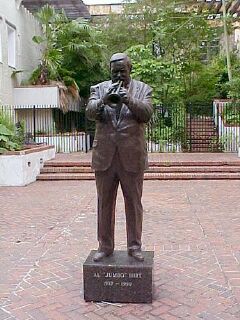






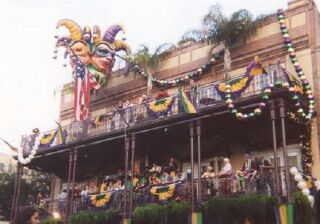
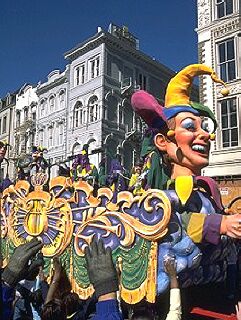
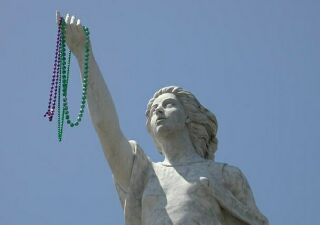
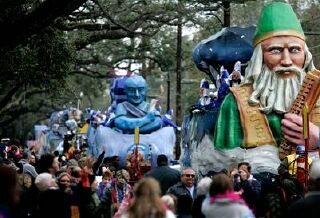
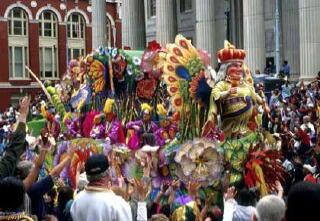
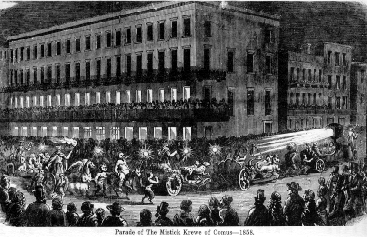
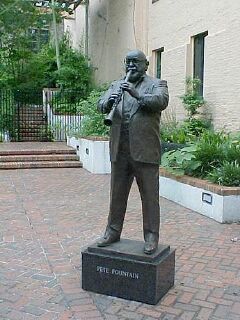
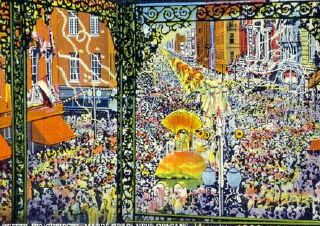
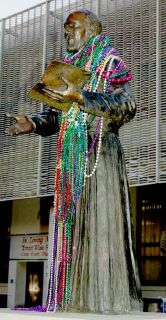
| On Mardi Gras, everybody says, 'Throw me something, Mister'... |
| ...even French heroine, Joan of Arc, above, & Bienville, right, who founded the city of New Orleans in 1718. |
| Purple: Justice Gold: Power Green: Faith |
| The Colors of Carnival |
| You Know You are Addicted to Mardi Gras When... You can tell the day of the week by which parade is rolling that day. Your first priority for buying a house is if it's on a parade route or not. Your marry into a family with a house on a parade route. You have memorized all the back streets behind the parades so that you can get from one parade to another without missing a float. You own a wardrobe of purple, green and gold clothes big enough to last the carnival season and, since the weather is so changeable, it includes both summer and winter styles. You go to sleep out under some type of makeshift tent at midnight in the pouring rain so you can have a prime spot for a parade the next day. You know where all the bathrooms are on the parade routes. You have a Christmas tree decorated in purple, green and gold and it stays up til Mardi Gras Day. |
| On the left, a statue honoring New Orleans musician Al Hirt; on the right, one honoring Pete Fountain. |
| Mardi Gras is a thing that could hardly exist in the practical North, for the soul of it is the romantic. Take away the romantic mysteries, the kings and knights and titles, and Mardi Gras would die down there in the South. -- Mark Twain Photo to the left is courtesy of Darin Hintz. |
| Just wait, you'll see, there are astonishing things to behold in that great city of New Orleans on Mardi Gras Day....things you have likely never seen before! -- John Jerome, 1883 |
| Though Mardi Gras had been celebrated since the 1700's in the city, the first parade of the Mystic Krewe of Comus took place in 1856; depiction of the event above. |
| Please don't use the "Send Page" feature of your computer to send this entire page in an e-mail message or document format. If you'd like to share it, please just send the link. The link to this page is: http://www.thepastwhispers.com/Mardi_Gras.html Music: If Ever I Cease to Love Back to Mardi Gras in Old New Orleans Back to Old New Orleans Whispers - Home |
| "If Ever I Cease to Love" |


| The song most associated with Mardi Gras, "If Ever I Cease to Love," was written by George Leybourne in 1871. When English songstress, Lydia Thompson, brought her show to America, she brought the song along. The romantic version of how the song came to be the unofficial Mardi Gras anthem is that the Russian Grand Duke Alexis Romanoff attended one of her performances while visiting America in 1872, and was immediately smitten with the singer. The legend goes on to say that, when the Grand Duke visited New Orleans at Carnival time that year, in his honor, the King of Carnival, issued an edict that all bands taking part in the newly created Rex parade--the first daytime parade ever held during Mardi Gras--were to play, passing in review, the Royal Anthem, "If Ever I Cease to Love." It's doubtful that the Grand Duke had fallen in love with Miss Thompson, but it's possible that he'd said something favorable about the song, and that the King of Carnival issued the proclamation in his honor. At any rate, the song has been played on Mardi Gras day during every Rex parade since 1872 and it's carried the names of Miss Thompson and Grand Duke Romanoff along with it. The music you're hearing now is a "jazzier" version than the original. |





| French Quarter balcony, Mardi Gras, 1920's. |
